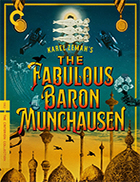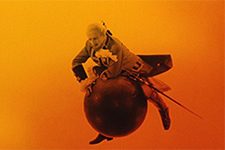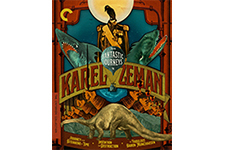| Director: Karel Zeman | | Screenplay: Karel Zeman (dialogue by Josef Kainar; narration by Jirí Brdecka; based on the works of Gottfried August Bürger and Rudolph Erich Raspe) | | Stars: Milos Kopecký (Baron Munchausen), Rudolf Jelínek (Tonik), Jana Brejchová (Princess Bianca), Karel Höger (Cyrano), Eduard Kohout (General Ellemerle), Jan Werich (Ship’s Captain), Bohus Záhorský (Admiral), Rudolf Hrusínský (The Sultan), Miroslav Holub (Enemy General), Frantisek Slégr (Pirate Captain), Karel Effa (Adjutant) | | MPAA Rating: NR | | Year of Release: 1962 | | Country: Czechoslovakia |  |
|  By the time the Czech animation director Karel Zeman made The Fabulous Baron Munchausen in 1962, his fourth feature-length film, there had already been two dozen or more cinematic takes on the titular character, a fanciful, adventurous German nobleman originally created by Rudolf Erich Raspe in the late 18th century. Silent filmmakers Georges Méliès, Paolo Azzurri, F. Martin Thornton, and pioneering animator Émile Cohl had all taken stabs at transposing the Baron’s wildly exaggerated escapades from page to screen, and the sound era saw new versions from Czech, German, and Soviet directors. It was no surprise that Zeman would be drawn to the character, as Baron Munchausen’s absurdist exploits were unhindered by the laws of physical reality (or logic, or reason, or rationality …) and therefore lent themselves quite nicely to Zeman’s unique style of experimental animation techniques merged with live action to bring the fantastical to grand cinematic life. Released several years after Zeman’s masterpiece Invention for Destruction (Vynález zkázy, 1958), an amalgamation of Jules Verne story lines and visual tropes made in the style of engraved Victorian illustrations, The Fabulous Baron Munchausen (Baron Prášil) is a looser, more experimental film—almost avant-garde in its disregard for a coherent style and narrative clarity. It is a gonzo, anything-goes extravaganza, with Zeman freely drawing from the large body of Baron Munchausen literature while also filling in gaps with his own ideas and, of course, Jules Verne. The story begins, in fact, on the moon, where we find the principle characters from Verne’s 1865 novel From the Earth to the Moon (De la terre à la lune) happily living on the lunar surface along with Cyrano de Bergerac (Karel Höger) and Baron Munchausen (Milos Kopecký) because … well, why not? They meet a modern-day astronaut named Tonik (Rudolf Jelínek), whom they mistake for a “Moonman.” Munchausen takes a particular interest in Tonik and decides to take him back to Earth, where they arrive in 18th-century Constantinople. From there, the film launches into a series of bizarre situation and adventures, a number of which involve a love triangle among Tonik, Princess Bianca (Jana Brejchová), a beautiful woman they rescue from the clutches of a Turkish sultan (Rudolf Hrusínský), and Munchausen, the latter of whom has a humorously inflated sense of himself and cannot understand how Bianca could have any interest in his romantic rival. We get sword fights, horse chases through the desert, daring rescues, and an extended sequence aboard a ship that is swallowed whole by an enormous fish. There is little rhyme or reason in connecting these various sequences outside of their shared outlandishness, which means that Zeman’s clever animation becomes the film’s fundamental connective tissue. Lacking a coherent theme, like we saw in Invention for Destruction, or characters that are more than amusing cartoons, The Fabulous Baron Munchausen doesn’t have much more than Zeman’s daring artistry, which stitches together various modes of animation and optical special effects to create a vibrant otherworld that maintains a consistent visual fascination. Some of the imagery is amusingly hokey (such as the giant fish and its cavernous innards), some of it is wonderfully bizarre (such as the sequence in which Munchausen rides under the ocean on a literal seahorse), and some of it mind-blowing in its complexity (I am thinking here about a long tracking shot that moves through the Sultan’s palace with layer after layer of animation). The Fabulous Baron Munchausen isn’t Zeman’s best film, but it is certainly one of his most ambitious and daring and is therefore a novel achievement in its own right. | The Fabulous Baron Munchausen Criterion Collection Blu-ray |  The Fabulous Baron Munchausen is available as part of The Criterion Collection’s “Three Fantastic Journeys by Karel Zeman” boxset, which also includes Journey to the Beginning of Time (1955) and Invention for Destruction (1958). The Fabulous Baron Munchausen is available as part of The Criterion Collection’s “Three Fantastic Journeys by Karel Zeman” boxset, which also includes Journey to the Beginning of Time (1955) and Invention for Destruction (1958). | | Aspect Ratio | 1.37:1 (all three films) | | Audio | Czech Linear PCM 1.0 monaural (all three films) | | Subtitles | English | | Supplements | Journey to the Beginning of Time“Directed by Karel Zeman” featurette “The Birth of a Film Legend” featurette“Why Zeman Made This Film” featurette“Where Was This Film Shot” featurette“Special Effects Techniques” featuretteRestoration demonstrationU.S. theatrical versionTrailer
Invention for DestructionAlternate U.S. opening (3:00)“Making Magic (23:29)Four early short films by Zeman: A Christmas Dream (1946), A Horseshoe for Luck (1946), Inspiration (1949), and King Lavra (1950)“Why Zeman Made the Film” featurette“Special Effects Techniques” featurette“About the Restoration” featuretteRestoration demonstrationTrailer
The Fabulous Baron MunchausenFilm Adventurer Karel Zeman documentary“Why Zeman Made the Film” featurette“Cast” featurette“Special Effects Techniques” featurette“Karel Zeman The Legend Continues” featurette“Karel Zeman and the World” featuretteRestoration demonstrationMuseum PromoTrailer | | Distributor | The Criterion Collection | | SRP | $79.96 | | Release Date | February 25, 2020 | | | COMMENTS | | All three films in Criterion’s beautifully designed and executed Karl Zeman boxset, which features pop-up artwork for each film that is worth the price alone, has been digitally restored in 4K as part of “Restoring the World of Fantasy,” a joint project undertaken by the Karen Zeman Museum, the Czech Film Foundation, and Czech Television. According to the liner notes, all three films were scanned from their original 35mm camera negatives (Journey to the Beginning of Time also made use of a 35mm duplicate positive because parts of the negative were damaged beyond repair). The images are absolutely gorgeous and bear no traces of age or wear. Journey’s colors look a bit faded and muted, but that seems to be the original look of the film. The Fabulous Baron Munchausen, on the other hand, is bright and bold, with a deeply saturated color palette. Invention for Destruction, the only one of the three in black-and-white, is also gorgeous, with the high-definition resolution drawing out the unique visual details that make the film appear as though it is an animated woodcut (all those thin, closely spaced horizontal lines must have been horrible in creating moiré effects in lower resolution video versions). The original monaural soundtrack for each film was mastered from the original 35mm sound negatives (with Journey once again making use of a 35mm duplicate positive) and sounds great. The supplements are quite extensive and are all but essential viewing if you are not fully familiar with Zeman’s story and his work. Each of the discs includes a series of short featurettes produced in 2015 for the Karel Zeman Museum that focuses on different aspects of the film: why Zeman made it, the special effects used, and how it was restored. Journey to the Beginning of Time also has a featurette about the locations where it was shot, while Baron Munchausen has one about the cast and two titled “Karel Zeman: The Legend Continues” and “Karel Zeman and the World,” as well as a short museum promo. Each of these featurettes runs between three and five minutes. The Journey disc also includes “The Birth of a Film Legend,” a 5-minute overview of Zeman’s life and career, a trailer, and the complete 1966 U.S. release version of the film, which differs quite substantially in the beginning and end because new footage of American kids (always with their backs to the camera) visiting an American museum was shot and edited in place of the opening footage in the original version (the transfer is not as good as the Czech version, but it still looks very good). The Invention for Destruction disc includes “Making Magic,” a fantastic 23-minute featurette in which special effects veterans Phil Tippett (Return of the Jedi, RoboCop) and Jim Aupperle (The Thing, Dreamscape) discuss what made Zeman’s work unique and innovative; four of Zeman’s short films—A Christmas Dream (1946), A Horseshoe for Luck (1946), Inspiration (1949), and King Lavra (1950); and the alternate opening credits sequence for the U.S. release version, where it was retitled The Fabulous World of Jules Verne. Finally, the Baron Munchausen disc includes Film Adventurer Karel Zeman (2015), a 100-minute biographical documentary that features interviews with many of Zeman’s collaborators as well as those who have been inspired by his work, including Tim Burton and Terry Gilliam. |
Copyright © 2020 James Kendrick Thoughts? E-mail James Kendrick All images copyright © The Criterion Collection |



 (3)
(3)

 The Fabulous Baron Munchausen is available as part of The Criterion Collection’s “Three Fantastic Journeys by Karel Zeman” boxset, which also includes Journey to the Beginning of Time (1955) and Invention for Destruction (1958).
The Fabulous Baron Munchausen is available as part of The Criterion Collection’s “Three Fantastic Journeys by Karel Zeman” boxset, which also includes Journey to the Beginning of Time (1955) and Invention for Destruction (1958).